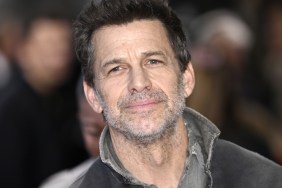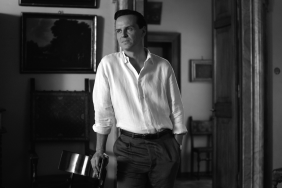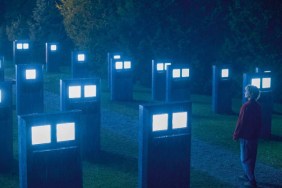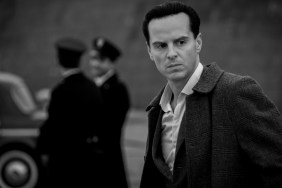
SHOCK looks at David Bowie’s mesmerizing performance in director Tony Scott’s 1983 vampire drama THE HUNGER.
Tony Scotts 1983 vampire drama THE HUNGER, his first film and an adaptation of author Whitley Striebers bestselling, same-named book, is a marvelous picture; stylish, beautiful, sensual, elegant and, at its core, almost overwhelmingly melancholy. Its no surprise then, that this hazy, dream-like work of neo-Gothic art faired poorly at the box-office, seeing as the dawn of the decade concerned itself mainly with post-STAR WARS and RAIDERS OF THE LOST ARK spectacle and, in the annals of horror, gory, brainless body count pictures.
But THE HUNGER is something different. Something special.
In it, revered French actress Catherine Deneuve plays Miriam Blaylock, statuesque female vampire, a creature who we are lead to believe has endured centuries, forever gliding through time, never aging and living off human blood. But she doesnt make this endless journey alone. Like Delphine Seyrigs similarly graceful and parasitic Countess Bathory in Harry Kumels DAUGHTERS OF DARKNESS, Miriam must always have a companion, a lover of her choosing whom is afflicted with a version of the disease that she has, the disease that blesses one with life eternal and an unnatural, murderous thirst.
Except Miriams lovers do not live on. Theirs is a comparatively brief dance with immortality, a cold fact her most recent paramour, John Blaylock, spends the first half of THE HUNGER dealing with.
Essaying the role of John is the late, great David Bowie, who, by 1983 had already proven himself as effective a presence on screen as he was on stage, so mesmerizing was he in films like Nicolas Roegs unforgettable dark fantasy THE MAN WHO FELL TO EARTH, Uli Edels CHRISTIANE F. and that same years grueling, Nagisa Oshima-directed war drama MERRY CHRISTMAS MR. LAWRENCE.
His work in THE HUNGER sits among his greatest performances and its the soul of the film.
The first thing we see in the movie, as we fade in from black, is the scowling face of dark rock legend Peter Murphy, who, along with his then band BAUHAUS (who remain off-screen, much to the bands own annoyance), locked in a cage at a nightclub, performing their signature Goth pop anthem Bela Lugosis Dead. Murphy had long styled his image after Ziggy Stardust-era Bowie and, for him, a young burgeoning rock idol, meeting Bowie on the set of an expensive Hollywood feature film was surreal.
Murphy had this to say to me about the experience, when I interviewed him in the pages of FANGORIA last summer:
Meeting him on set was one of the most exciting moments of our early career we were all part of that early 1970s scene that was obsessed with all that influential Bowie stuff. We loved Bowie we showed up at 5:30am in the morning to start the performance at this dark, empty club and there wasnt really anyone around, save for some of the crew and Tony. But there was this balcony above us and, in the third take of doing the song, I just kind of felt that Bowie was there. It was tangible when he arrived, this whole experience and I actually wasnt even really sure I wanted to meet him you know, this artist who had a certain mythical quality to me. Because all of our heroes are our own creations, anyway, arent they? So his assistant came up to me after one of the takes and said That was a wonderful performance! and I looked up to that balcony and Bowie was up there looking down and gave me this kind of approving nod. I had to leave and go to the dressing room, it was just too much, I couldnt be there. I was like, Stop looking at me, Bowie! So, anyway, I found out that our dressing room was next to his and we had to hang around all day to do several retakes while they shot other scenes with the crowds and extras. Bowie at one point came to my dressing room and I had this Brandy bar in my room and I nervously asked him in. To me, he was a figurehead. He was much more than a person. And all I could think of asking him was Uh do you want some Brandy?. I must have looked like a complete drunk. I had this Brandy in my hand and I was all shaky and nervous. But he was awesome ”
In the following minutes, as the credits begin, we are treated to a cross-cut montage of wordless images that tell a story. We see Murphy, slamming his weight against that cage, the slickly dressed patrons of the club grinding their bodies to the music; we see Miriam, horn-rimmed sunglasses, dragging on a cigarette, watching the people below; we see John, his own rounded-lensed glasses tipped to eye- target a young post-punk couple, who stare back at him. Miriam approves. Murphy snarls. The quartet exit.

As the first hints of sun scrape the sky, they quickly drive to the young couples home, for a round of drinks and presumably kinky sex. Drinks, yes. Sex, yes. And its kinkier than the swinging lovers could ever imagine.
As the girl (Ann Magnuson) writhes in front of a white screen, blue light projected on her, accentuating the shadow of Miriam, still dragging that cigarette, to the right of the frame, the man (John Stephen Hill) reclines on the couch laughing, while John speaks the first line of dialogue in the film, vibrating through the din of composer Denny Jaeger’s experimental, ambient throb:
No ice
John and the girl venture into the kitchen and, while Miriam mounts the man, John spreads the girls legs wide and removes her shirt, both of them grinning with purpose and lust. His hands knead her breasts, he runs his tongue up her neck and they kiss, strings of saliva connecting their mouths as tongues push out and touch.
Hanging from his neck is an Egyptian Ankh, a symbol of life; bit this Ankh is actually a sheathed dagger and, as John moves his head hungrily between the girls legs, that blade is removed and a cut is made, presumably, down below. John feeds from the screaming girl as Miriam opens the throat of the man.
Blood runs freely
This spectacularly violent and sexual opening then gives way to the almost meditative sadness that fuels the rest of the picture. We see John and Miriams hands cleaning the blood from their hands in the sink, their killing Ankhs clanking on the metal of the drain and the red circling and spiraling down.
The pair drive home at dawn while a sparse, delicate Shubert piano piece weeps in the background. They arrive at their Manhattan brownstone and, after cremating their victims, shower, their nude bodies sprayed with water and enveloped by steam. But while Miriam seems perfectly content, John is not. He stares at his wife, his muse, his Queen and, almost childlike, reaches apprehensively for her.
Forever? he almost whispers.
What? she asks.
Forever and ever?
To that, she has no answer.
Because Johns time is running out. He knows this. She knows this. And though she tries to deny it, John is forced to endure the emotional and physical finality of life.

The following section of the film essays that process, in wrenching detail and, with anyone other than David Bowie playing the character, I cant imagine the effect would be as profound; theres a poetry and grace in his incarnation of John Blaylock, one whose silences are almost musical, the wordless look of pain and fear in his eyes, quietly devastating
As sleeplessness grips him, as wrinkles draw across his skin, as his hair falls out in clumps and he stares in the mirror, not quite recognizing the image that stares back, as he stumbles through the city streets and people begin treating him differently, not as a man, but as something outdated and worthless, we feel his agony and, despite the ruthless, predatory nature he revealed during the films ice-cold opening, we feel for him.
We weep for John Blaylock. Because we understand what it is to lose youth.
We know that the hunger of the title isnt just a hunger for blood, its a hunger to hold on to life, to love, to all of those moments that make us what we are, in that brief period of our lives that we shine, when we are at our best. Seeing John crumble and worse, accept his fate, is difficult because, on a less phantasmagorical level, its what we all must eventually accept and endure.

And when John finally succumbs and Bowie exits the picture, THE HUNGER loses some of its own life. Without Bowie, theres no heart left, no emotional thrust. Its a pretty picture, an attractive vessel that sort of drifts to its conclusion without purpose.
And its hard to watch THE HUNGER now, after Bowies own passing and not think that maybe these past 18 months, as the performer battled the cancer that would eventually take his life, he might have felt a bit like John Blaylock himself, raging against the dying of his light.
if you were one of the millions who followed David Bowie in any or all of his many incarnations, if his music, his art, his movies and his mind moved you, this is a day you will remember. Because if a mythical figure like Bowie can fall, then certainly, so can we…
But, then again, as actor Simon Pegg tweeted today:
If youre sad today, just remember that the world is over 4 billion years old and you somehow managed to exist at the same time as David Bowie.
Amen to that.
And here’s to Bowie’s work in THE HUNGER, one of many incredibly effective detours in a remarkable career.









